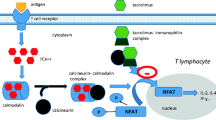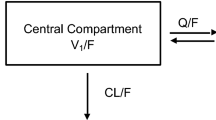Abstract
Objective
Our objective was to identify common factors that determine the dose of tacrolimus and microemulsified cyclosporin in paediatric renal transplant recipients.
Methods
The concentration profiles of tacrolimus and cyclosporin in blood were determined in 68 children who had received a renal transplant. To avoid disruption of therapy, measurements were made at 2-h intervals over an 8-h period during normal dosing regimens. Direct comparisons of the two drugs were made in 14 of the subjects who were switched from cyclosporin to tacrolimus.
Results
The ratio of peak to trough levels for tacrolimus was approximately twofold compared with over threefold for cyclosporin. Area under the curve (AUC) for tacrolimus remained relatively constant in each 2-h period of the dosage interval compared with the AUC for cyclosporin, which varied by over twofold in the same time period. In the 14 subjects who received both drugs, there was a poor correlation between C2/C0, C2, t1/2 and AUC for tacrolimus and cyclosporin in the same individual. In a multivariate analysis, there were no significant associations for tacrolimus concentrations, AUC or C2/C0 with age, gender, calcium-channel blocker, quinolone or statin. For cyclosporin, there was some association for AUC with gender and quinolone use and a weak association with calcium-channel blocker or statin use.
Conclusions
Tacrolimus and microemulsified cyclosporin display a wide intra- and inter-individual variation in pharmacokinetic properties in young subjects. In the case of absorption represented by the peak-trough ratios, the values for tacrolimus are significantly less than those obtained with cyclosporin. The pharmacokinetic parameters obtained for one of these agents is not predictive for the behaviour of the other in young renal transplant recipients.


Similar content being viewed by others

References
Anglicheau D, Flamant M, Schlageter MH, Martinez F, Cassinat B, Beaune P, Legendre C, Thervet E (2003) Pharmacokinetic interaction between corticosteroids and tacrolimus after renal transplantation. Nephrol Dial Transplant 18:2409–2414
Braun F, Schutz E, Peters B, Talaulicar R, Grupp C, Undre N, Schafer A, Armstrong VW, Oellerich M, Ringe B (2001) Pharmacokinetics of tacrolimus primary immunosuppression in kidney transplant recipients. Transplant Proc 33:2127–2128
Combalbert J, Fabre I, Fabre G, Dalet I, Derancourt J, Cano JP, Maurel P (1989) Metabolism of cyclosporin A. IV. Purification and identification of the rifampicin-inducible human liver cytochrome P 450 (cyclosporin A oxidase) as a product of P 450IIIA gene subfamily. Drug Metab Dispos 17:197–207
Crocker JF, Renton KW, LeVatte TL, McLellan DH (1994) The interaction of the calcium channel blockers verapamil and nifedipine with cyclosporin A in pediatric renal transplant patients. Pediatr Nephrol 8:408–411
Dunn CJ, Wagstaff AJ, Perry CM, Plosker GL, Goa KL (2001) Cyclosporin: an updated review of the pharmacokinetic properties, clinical efficacy and tolerability of a microemulsion-based formulation (neoral)1 in organ transplantation. Drugs 61:1957–2016
Filler G, Feber J, Lepage N, Weiler G, Mai I (2002) Universal approach to pharmacokinetic monitoring of immunosuppressive agents in children. Pediatr Transplant 6:411–418
Filler G, Trompeter R, Webb NJ, Watson AR, Milford DV, Tyden G, Grenda R, Janda J, Hughes D, Offner G, Klare B, Zacchello G, Brekke IB, McGraw M, Perner F, Ghio L, Balzar E, Friman S, Gusmano R, Stolpe J (2002) One-year glomerular filtration rate predicts graft survival in pediatric renal recipients: a randomized trial of tacrolimus vs cyclosporine microemulsion. Transplant Proc 34:1935–1938
Hasegawa A, Takahashi K, Ito K, Oshima S, Uchida K, Sonoda T (2002) Optimal use of tacrolimus in living donor renal transplantation in children. Transplant Proc 34:1939–1941
Hesselink DA, van Schaik RH, van der Heiden IP, van der Werf M, Gregoor PJ, Lindemans J, Weimar W, van Gelder T (2003) Genetic polymorphisms of the CYP3A4, CYP3A5, and MDR-1 genes and pharmacokinetics of the calcineurin inhibitors cyclosporine and tacrolimus. Clin Pharmacol Ther 74:245–254
Kaplan B, Schold JD, Meier-Kriesche HU (2003) Long-term graft survival with neoral and tacrolimus: a paired kidney analysis. J Am Soc Nephrol 14:2980–2984
Karamperis N, Povlsen JV, Hojskov C, Poulsen JH, Pedersen AR, Jorgensen KA (2003) Comparison of the pharmacokinetics of tacrolimus and cyclosporine at equivalent molecular doses. Transplant Proc 35:1314–1318
Karanam BV, Vincent SH, Newton DJ, Wang RW, Chiu SH (1994) FK 506 metabolism in human liver microsomes: investigation of the involvement of cytochrome P 450 isozymes other than CYP3A4. Drug Metab Dispos 22:811–814
Kelles A, Van Damme-Lombaerts R, Tjandra-Maga TB, Van Damme B (1996) Long-term cyclosporin A pharmacokinetic profiles in pediatric renal transplant recipients. Transpl Int 9:546–550
Kelles A, Herman J, Tjandra-Maga TB, Van Damme-Lombaerts R (1998) Sandimmun-to-Neoral conversion in stable pediatric kidney transplant recipients. Transplant Proc 30:1995–1996
Kelles A, Herman J, Tjandra-Maga TB, Van Damme-Lombaerts R (1999) Sandimmune to Neoral conversion and value of abbreviated AUC monitoring in stable pediatric kidney transplant recipients. Pediatr Transplant 3:282–287
Keown PA (2002) New concepts in cyclosporine monitoring. Curr Opin Nephrol Hypertens 11:619–626
Lindholm A (1995) Cyclosporine A: clinical experience and therapeutic drug monitoring. Ther Drug Monit 17:631–637
Lindholm A, Sawe J (1995) Pharmacokinetics and therapeutic drug monitoring of immunosuppressants. Ther Drug Monit 17:570–573
Macphee IA, Fredericks S, Tai T, Syrris P, Carter ND, Johnston A, Goldberg L, Holt DW (2002) Tacrolimus pharmacogenetics: polymorphisms associated with expression of cytochrome P 450 3A5 and P-glycoprotein correlate with dose requirement. Transplantation 74:1486–1489
Manzanares C (2002) Therapeutic drug monitoring of tacrolimus: a moving matter. Therapie 57:133–136
McLellan RA, Drobitch RK, McLellan H, Acott PD, Crocker JF, Renton KW (1995) Norfloxacin interferes with cyclosporine disposition in pediatric patients undergoing renal transplantation. Clin Pharmacol Ther 58:322–327
McLellan RA, Drobitch RK, Monshower M, Renton KW (1996) Fluoroquinolone antibiotics inhibit cytochrome P 450-mediated microsomal drug metabolism in rat and human. Drug Metab Dispos 24:1134–1138
Meier-Kriesche HU, Swinford R, Kahan BD, Brannan P, Portman RJ (2000) Reduced variability of neoral pharmacokinetic studies in pediatric renal transplantation. Pediatr Nephrol 15:2–6
Min DI, Lee M, Ku YM, Flanigan M (2000) Gender-dependent racial difference in disposition of cyclosporine among healthy African American and white volunteers. Clin Pharmacol Ther 68:478–486
Molpeceres J, Chacon M, Guzman M, Aberturas MR, Berges L (2000) Dependency of cyclosporine tissue distribution and metabolism on the age and gender of rats after a single intravenous dose. Int J Pharm 197:129–141
Oellerich M, Armstrong VW (2002) Two-hour cyclosporine concentration determination: an appropriate tool to monitor neoral therapy? Ther Drug Monit 24:40–46
O’Grady JG, Burroughs A, Hardy P, Elbourne D, Truesdale A (2002) Tacrolimus versus microemulsified ciclosporin in liver transplantation: the TMC randomised controlled trial. Lancet 360:1119–1125
Peters DH, Fitton A, Plosker GL, Faulds D (1993) Tacrolimus. A review of its pharmacology, and therapeutic potential in hepatic and renal transplantation. Drugs 46:746–794
Petz W, Spada M, Bertani A, Lucianctti A, Casagrande F, Guizzetti M, Corno V, Colledan M, Strazzabosco M, Gridelli B (2002) Experience with the use of basiliximab in liver transplantation—use in pediatric and adult recipients in combination with cyclosporine or tacrolimus. Transplant Proc 34:1966–1967
Przepiorka D, Blamble D, Hilsenbeck S, Danielson M, Krance R, Chan KW (2000) Tacrolimus clearance is age-dependent within the pediatric population. Bone Marrow Transplant 26:601–605
Reding R (2002) Tacrolimus in pediatric liver transplantation. Pediatr Transplant 6:447–451
Reding R, Sokal E, Paul K, Janssen M, Evrard V, Wilmotte L, Chardot C, Otte JB, Wallemacq P (2002) Efficacy and pharmacokinetics of tacrolimus oral suspension in pediatric liver transplant recipients. Pediatr Transplant 6:124–126
Scott LJ, McKeage K, Keam SJ, Plosker GL (2003) Tacrolimus: a further update of its use in the management of organ transplantation. Drugs 63:1247–1297
Shishido S, Asanuma H, Tajima E, Honda M, Nakai H (2001) Pharmacokinetics of tacrolimus in pediatric renal transplant recipients. Transplant Proc 33:1066–1068
Spencer CM, Goa KL, Gillis JC (1997) Tacrolimus. An update of its pharmacology and clinical efficacy in the management of organ transplantation. Drugs 54:925–975
Staatz CE, Taylor PJ, Lynch SV, Willis C, Charles BG, Tett SE (2001) Population pharmacokinetics of tacrolimus in children who receive cut-down or full liver transplants. Transplantation 72:1056–1061
Trompeter R, Filler G, Webb NJ, Watson AR, Milford DV, Tyden G, Grenda R, Janda J, Hughes D, Ehrich JH, Klare B, Zacchello G, Bjorn Brekke I, McGraw M, Perner F, Ghio L, Balzar E, Friman S, Gusmano R, Stolpe J (2002) Randomized trial of tacrolimus versus cyclosporin microemulsion in renal transplantation. Pediatr Nephrol 17:141–149
Trompeter R, Fitzpatrick M, Hutchinson C, Johnston A (2003) Longitudinal evaluation of the pharmacokinetics of cyclosporin microemulsion (Neoral) in pediatric renal transplant recipients and assessment of C2 level as a marker for absorption. Pediatr Transplant 7:282–288
Wallemacq PE, Verbeeck RK (2001) Comparative clinical pharmacokinetics of tacrolimus in paediatric and adult patients. Clin Pharmacokinet 40:283–295
Webb NJ, Stevenson PJ, Lewis MA, Postlethwaite RJ, Bradbury MG, Undre NA (2002) Pharmacokinetics of tacrolimus in paediatric renal transplant recipients. Transplant Proc 34:1948–1950
Wigger M, Druckler E, Muscheites J, Stolpe HJ, Kundt G, Wacke R (2003) Comparison of cyclosporine absorption profiles over a 12-month period in stable pediatric renal transplant recipients. Transplant Proc 35:1300–1303
Yates CR, Zhang W, Song P, Li S, Gaber AO, Kotb M, Honaker MR, Alloway RR, Meibohm B (2003) The effect of CYP3A5 and MDR1 polymorphic expression on cyclosporine oral disposition in renal transplant patients. J Clin Pharmacol 43:555–564
Yokogawa K, Shimada T, Higashi Y, Itoh Y, Masue T, Ishizaki J, Asahi M, Miyamoto K (2002) Modulation of mdr1a and CYP3A gene expression in the intestine and liver as possible cause of changes in the cyclosporin A disposition kinetics by dexamethasone. Biochem Pharmacol 63:777–783
Author information
Authors and Affiliations
Corresponding author
Rights and permissions
About this article
Cite this article
Renton, K.W., Crocker, J.F.S., McLellan, H. et al. A comparison of the pharmacokinetics of tacrolimus and microemulsified cyclosporin in paediatric renal transplant recipients. Eur J Clin Pharmacol 60, 421–426 (2004). https://doi.org/10.1007/s00228-004-0773-9
Received:
Accepted:
Published:
Issue Date:
DOI: https://doi.org/10.1007/s00228-004-0773-9



